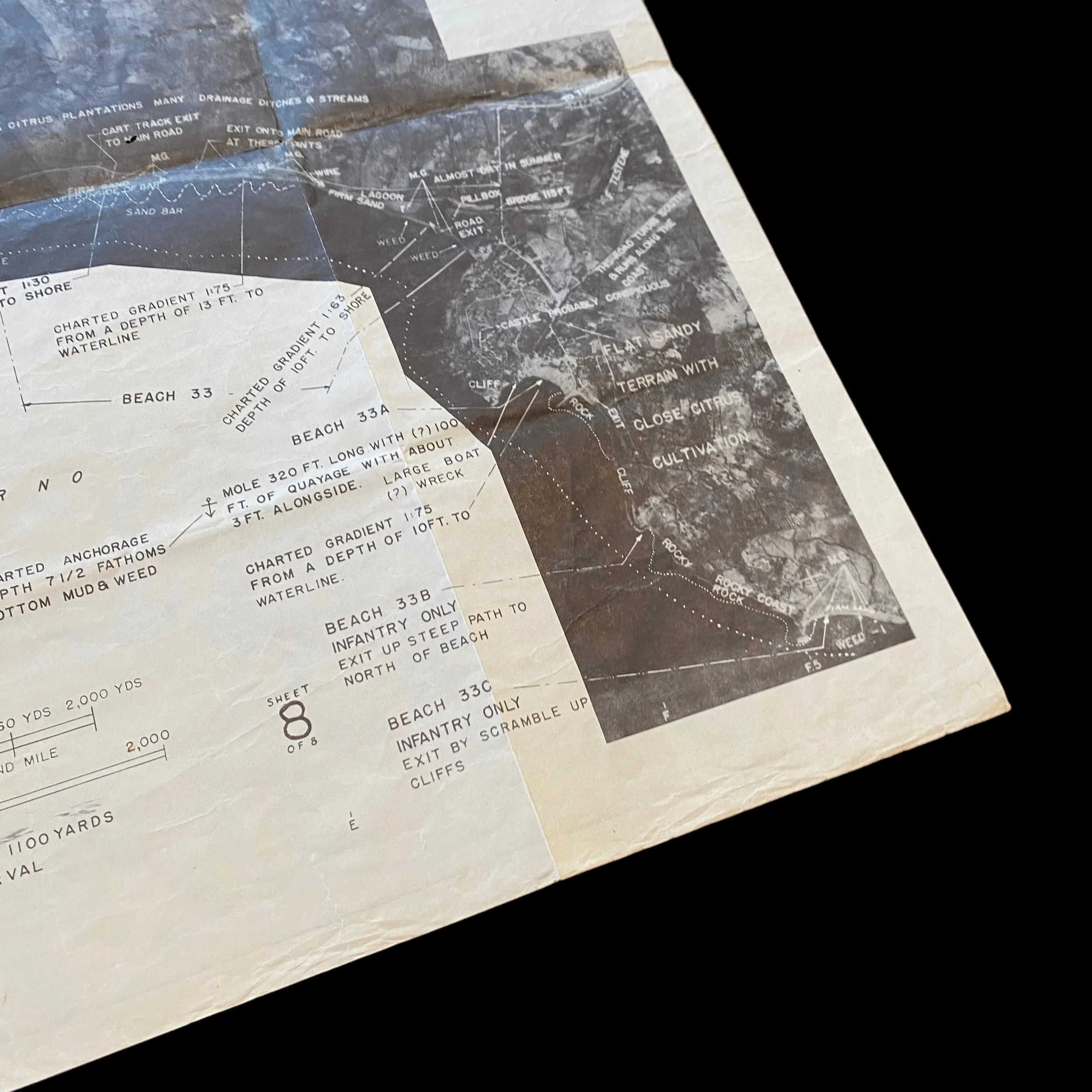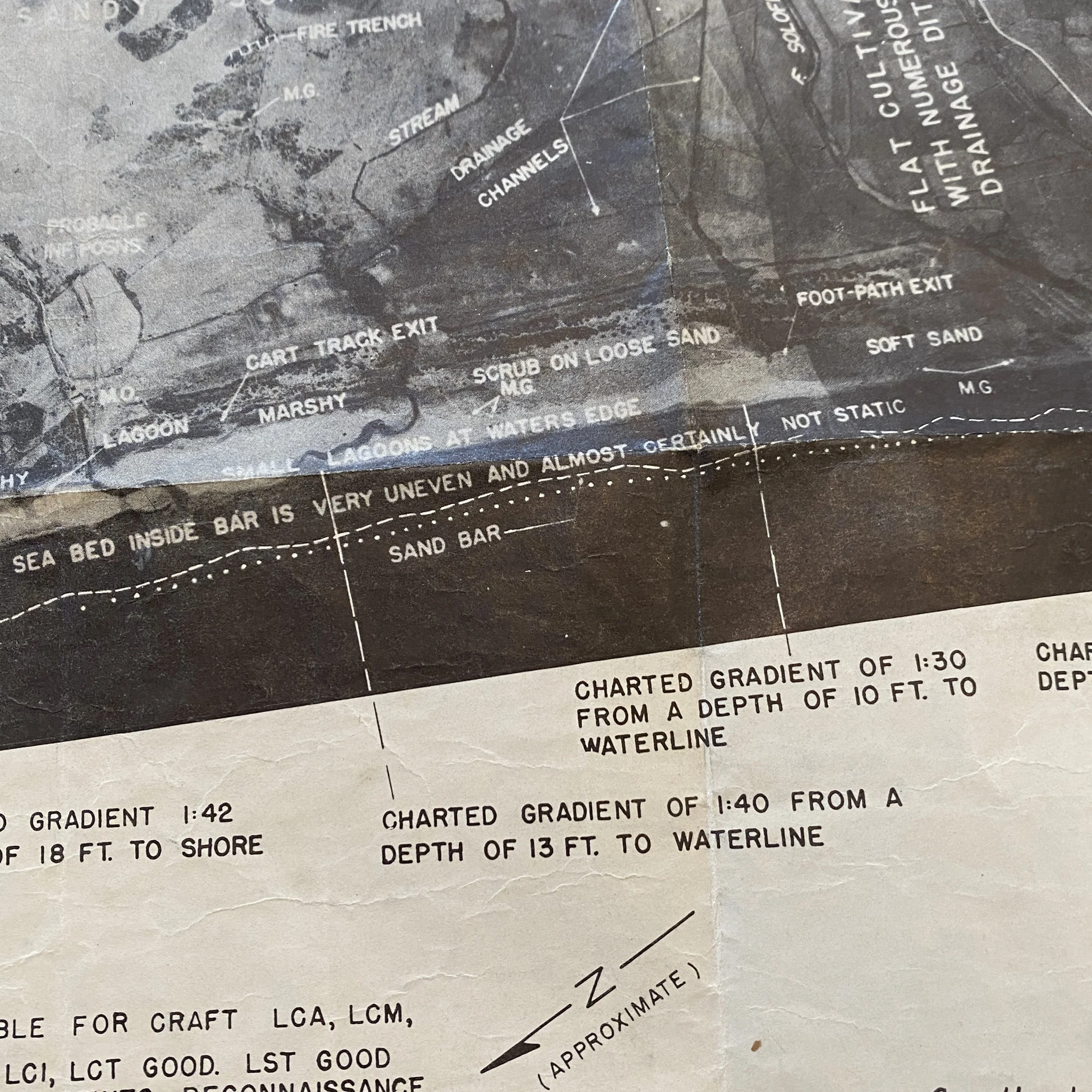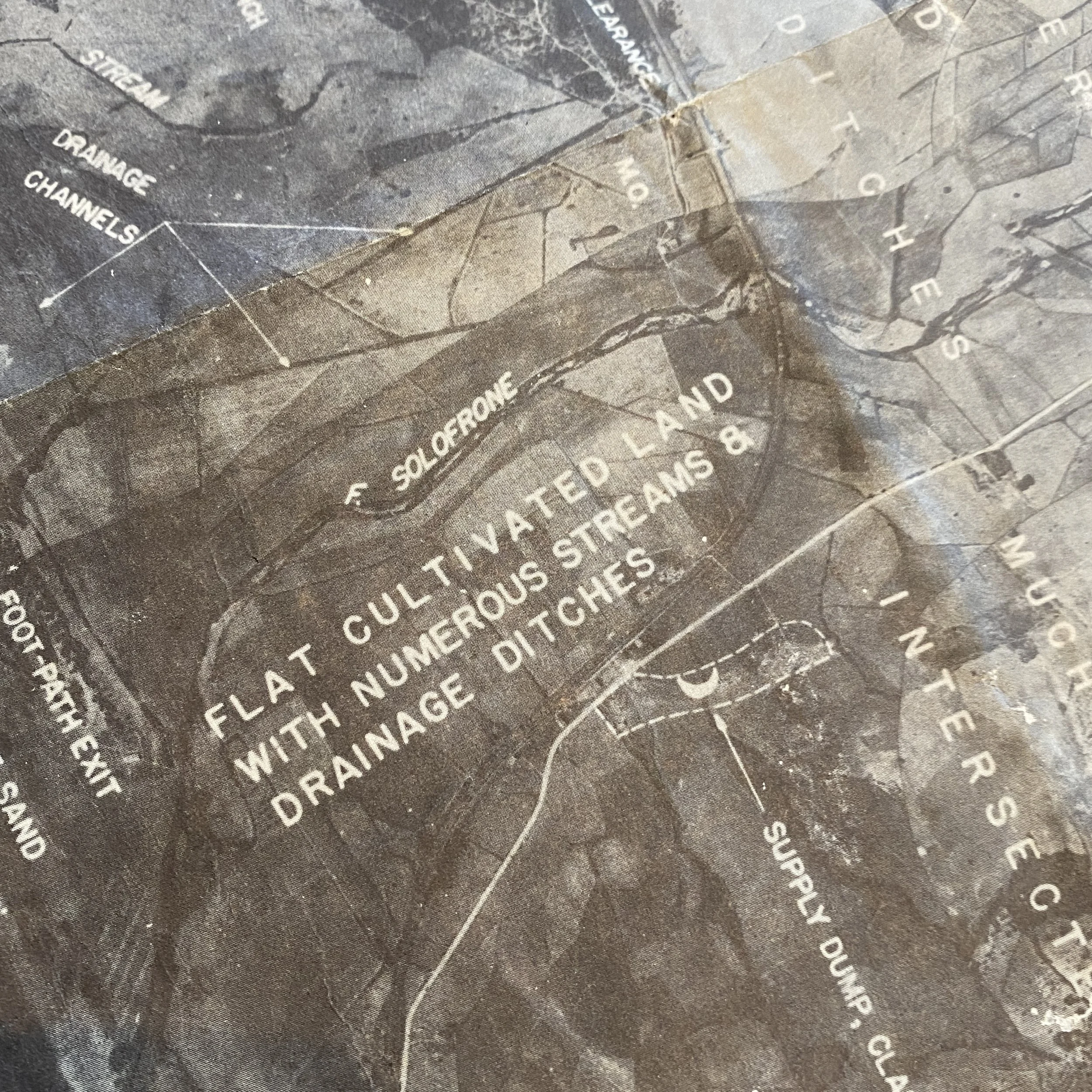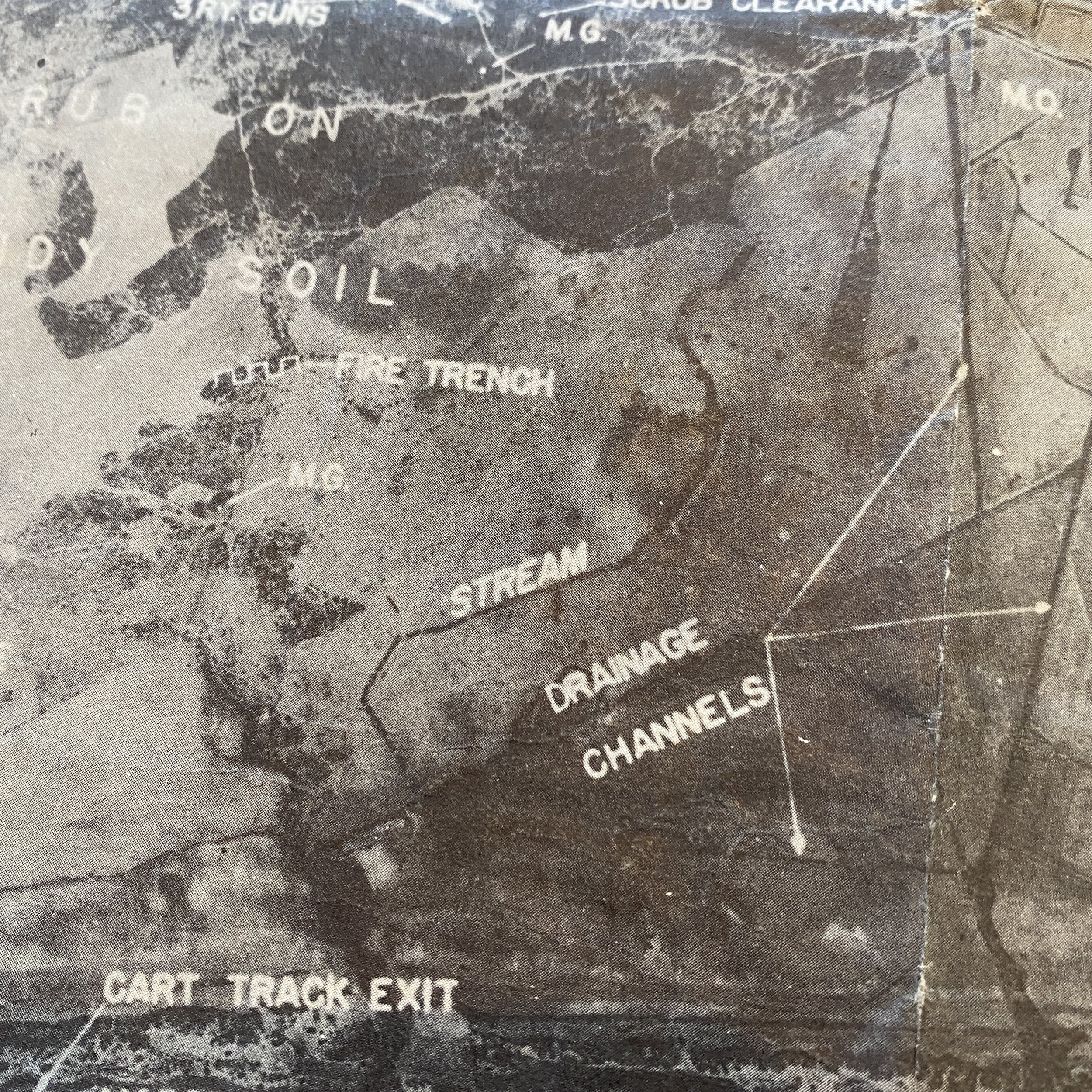VERY RARE! WWII U.S. VI Corps (45th Infantry Division & 36th Infantry Division) "SECRET" D-Day Southern France BIGOT "BEACH 32 and BEACH 33" Invasion Map*





































VERY RARE! WWII U.S. VI Corps (45th Infantry Division & 36th Infantry Division) "SECRET" D-Day Southern France BIGOT "BEACH 32 and BEACH 33" Invasion Map*
Comes with hand-signed C.O.A.
OPERATION AVALANCHE D-DAY BIGOT MAP MARKED NO. #261
THERE ARE VERY FEW OF THESE THAT STILL EXIST MAKING THIS A ONCE-IN-A-LIFETIME ADDITION TO ANY RARE MAP OR D-DAY COLLECTION.
This “SECRET” D-Day Gulf of Salerno Beach BIGOT map includes all of the landing craft specified/designated landing areas of BEACH 32 and BEACH 33 that were assigned to the U.S. VI Corps - 45th Infantry Division and 36th Infantry Division. This BIGOT map also shows the Airborne drop zones near Paestum assigned to the U.S. 504th Parachute Infantry Regiment and 505th Parachute Infantry Regiment.
Titled “GULF OF SALERNO - OPERATION AVALANCHE ” this original, ultra rare, and museum-grade SECRET “BIGOT” D-Day Invasion of Southern France amphibious beach chart vividly illustrates the intensive planning and operational accuracy that was behind Operation Avalanche, in coordination with the D-Day invasion of Northern France (the largest amphibious seaborne invasion in history).
This Operation Avalanche “Defense Beach and Underwater Information Uncontrolled Mosaic” map was created from top secret Allied aerial photographic recon missions on July 26th, 1943. This SECRET BIGOT map was prepared by the Joint Army Navy Intelligence Section and is map number #261 produced.
Many thousands of lives depended upon the success of the operation – millions in fact, it was thus vital that this map contained as much information as possible on this coastal section to insure the most military success for the Allied Powers.
The BIGOT classification
BIGOT was the highest-level military security classification, above Top Secret. Some sources suggest that it was an acronym for “British Invasion of German Occupied Territory;” others, that it was a “backronym” for “To Gib,” the code stamped on the papers of officers headed to Gibraltar in advance of the 1942 North Africa invasion.
Whatever the origins of the term, extraordinary efforts were made to protect BIGOT-level material. When for example a practice landing (“Operation Tiger”) on the Devon coast was ambushed by U-boats, Eisenhower himself ordered the recovery of the bodies of the ten known victims with BIGOT clearance. This was necessary to prove that they had not been captured alive, as their capture would have compromised the invasion plans and necessitated its cancellation.
Operation Avalanche:
Operation Avalanche was the codename for the Allied landings near the port of Salerno, executed on 9 September 1943, part of the Allied invasion of Italy during World War II. The Italians withdrew from the war the day before the invasion, but the Allies landed in an area defended by German troops. Planned under the name Top Hat, it was supported by the deception plan Operation Boardman.
The landings were carried out by the U.S. Fifth Army, under Lieutenant General Mark W. Clark. It comprised the U.S. VI Corps, the British X Corps, and the U.S. 82nd Airborne Division, a total of about nine divisions. Its primary objectives were to seize the port of Naples to ensure resupply, and to cut across to the east coast, trapping the Axis troops further south.
In order to draw troops away from the landing ground, Operation Baytown was mounted. This was a landing by the British Eighth Army, under General Sir Bernard Montgomery, in Calabria in the 'toe' of Italy, on 3 September. Simultaneous sea landings were made by the British 1st Airborne Division at the port of Taranto (Operation Slapstick). The Salerno landings were carried out without previous naval or aerial bombardment in order to achieve surprise. Surprise was not achieved.
The Germans had established artillery and machine-gun posts and scattered tanks through the landing zones which made progress difficult, but the beach areas were captured. Around 07:00 a concerted counterattack was made by the 16th Panzer Division. It caused heavy casualties but was beaten off. Both the British and the Americans made slow progress, and still had a 10 miles (16 km) gap between them at the end of day one. They linked up by the end of day two and occupied 35–45 miles (56–72 km) of coastline to a depth of 6–7 miles (9.7–11.3 km).
Over 12–14 September the Germans organized a concerted counterattack by six divisions of motorized troops, hoping to throw the Salerno beachhead into the sea before it could link with the British Eighth Army. Heavy casualties were inflicted, as the Allied troops were too thinly spread to be able to resist concentrated attacks.[4] The outermost troops were therefore withdrawn in order to reduce the perimeter. The new perimeter was held with the assistance of naval and aerial support, although the German attacks reached almost to the beaches in places.
The Plan:
The main landings were scheduled one week later, 9 September. The main force would land around Salerno on the western coast in Operation Avalanche. It would consist of the U.S. Fifth Army under Lieutenant General Mark W. Clark, comprising the U.S. VI Corps under Major General Ernest J. Dawley, the X British Corps under Lieutenant-General Richard McCreery, and the U.S. 82nd Airborne Division in reserve, a total of about nine divisions. Its primary objectives were to seize the port of Naples to ensure resupply, and to cut across to the east coast, trapping Axis troops further south. The inclusion of the 82nd Airborne Division as a reserve force was possible only with the cancellation of Operation Giant II. The 1st British Airborne Division would be landed by sea near Taranto, on the "heel" of Italy in Operation Slapstick, as a diversion for Salerno. Their task was to capture the port and several nearby airfields and link with the Eighth Army before pressing north to join the Fifth Army near Foggia.
The plan was deeply flawed. The Fifth Army would be landing on a very broad 35-mile front, using only three assault divisions, and the two corps were widely separated both in distance and by a river. Furthermore, the terrain was highly favorable to the defender. A U.S. Army Ranger force under Colonel William Orlando Darby consisting of three Ranger battalions and two British Commando units was tasked with holding the mountain passes leading to Naples, but no plan existed for linking the Ranger force with X Corps' follow-up units. Finally, although tactical surprise was unlikely, Clark ordered that no naval preparatory bombardment take place, despite experience in the Pacific Theater demonstrating it was absolutely necessary.
Approximately eight German divisions were positioned to cover possible landing sites, including the Hermann Goering Division, 26th and 16th Panzer, the 15th and 29th Panzergrenadier, and the 1st and 2nd Fallschirmjäger.
The Landings:
At Salerno the decision had been taken to assault without previous naval or aerial bombardment, in order to secure surprise. Tactical surprise was not achieved, as the naval commanders had predicted. As the first wave approached the shore at Paestum a loudspeaker from the landing area proclaimed in English, "Come on in and give up. We have you covered." The troops attacked nonetheless.
The Germans had established artillery and machine-gun posts and scattered tanks through the landing zones which made progress difficult, but the beach areas were successfully taken. Around 07:00 a concerted counterattack was made by the 16th Panzer division. It caused heavy casualties, but was beaten off with naval gunfire support. Both the British and the Americans made slow progress, and still had a 10-mile gap between them at the end of day one. They linked up by the end of day two and occupied 35–45 miles of coast line to a depth of six or seven miles.
General Montgomery had predicted Baytown would be a waste of effort because it assumed the Germans would give battle in Calabria; if they failed to do so, the diversion would not work. He was proved correct. After Baytown, the Eighth Army marched 300 miles (480 km) north to the Salerno area against no opposition other than engineer obstacles.
During September 12–14 the Germans organized a concerted counterattack with six divisions of motorised troops, hoping to throw the Salerno beachhead into the sea before it could link with the British 8th Army. Heavy casualties were inflicted, as the Allied troops were too thinly spread to be able to resist concentrated attacks. The outermost troops were therefore withdrawn in order to reduce the perimeter. The new perimeter was held with the assistance of 4,000 paratroopers from the 82nd and 509th PIB who air dropped near the hot spots, from strong naval gunfire support, and from well-served Fifth Army artillery. The German attacks reached almost to the beaches but ultimately failed. The heavy gunfire of Allied battleships practically immobilised counterattacking German units with their sheer firepower, forcing the Germans to halt their counteroffensive and regroup.[8]
General Clark was awarded the Distinguished Service Cross, the second-highest US award for valor in combat, for his front-line leadership during this crisis. He was frequently seen in the most forward positions encouraging the troops. However, in the estimate of historian Carlo D'Este, Clark's poor planning of the operation caused the crisis in the first place.
USS Savannah being struck by a German guided bomb off Salerno, 197 crewmen died in the attack and another 15 were injured[9]
The Salerno battle was also the site of a mutiny by about 600 men of the British 10th Corps, who on September 16 refused assignment to new units as replacements. They had previously understood that they would be returning to their own units from which they had been separated during the fighting in the North African Campaign, mainly because they had been wounded. Eventually the Corps commander, McCreery, persuaded most of the men to follow their orders. The NCOs who led the mutiny were sentenced to death, but were eventually allowed to rejoin units and the sentence was not carried out.